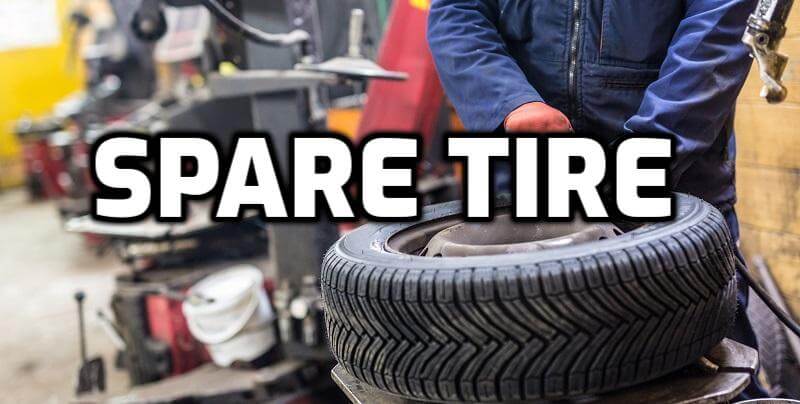What Size Spare Tire Do I Need?

A flat tire can be a major inconvenience, especially when you’re far from home or a service station. Having a spare tire in your vehicle can save you from being stranded and help you get back on the road quickly.
Spare tires come in various types, each with its advantages and disadvantages. This article will discuss the different spare tire types, help you determine the right size for your vehicle, and explain the importance of matching the spare tire with your vehicle’s specifications.
Types of Spares
Type of Spare Tire can help you understand which type of spare tire you need when you have a puncture or blowout. There are three types of spare tires.
Full-Size Spare
A full-size spare is the same size as the tires on your car. These are typically found on larger vehicles, such as SUVs and trucks. If you have a full-size spare, you will not have to worry about changing your tire size when you get a flat.
- Advantages: A full-size spare tire is an exact match to the other tires on your vehicle. It offers the same performance, load-carrying capacity, and overall compatibility with your vehicle’s systems. Since it’s the same size and type as your regular tires, you can drive on it at the same speeds and for the same distances without any limitations.
- Disadvantages: The primary disadvantage of a full-size spare tire is its size and weight. It takes up more trunk space and adds extra weight to your vehicle, which can affect fuel efficiency. Additionally, full-size spares can be more expensive than other spare tire options.
Space-Saver Spare
A temporary spare, also known as a “donut,” is a smaller spare tire meant to be used for a short period. These are typically found on smaller vehicles, such as sedans and coupes.
- Advantages: Compact spare tires, also known as space-saver spares or donuts, are smaller and lighter than full-size spare tires. They’re designed to save space and weight, making them a popular choice for many drivers. They’re also less expensive than full-size spares.
- Disadvantages: Space-saver spare tires are intended for temporary use and have limited speed and distance restrictions. They’re not designed for high-speed driving or long distances, as they can affect your vehicle’s handling and braking performance. Additionally, their smaller size may not provide adequate load-carrying capacity for some vehicles.
Run-Flat Tires
A compact spare is a smaller spare tire meant to be used for a shorter period than a temporary spare. These are typically found on smaller vehicles, such as hatchbacks and wagons. If you have a compact spare, you must change your tire size when you get a flat.
- Advantages: Run-flat tires are designed to maintain their structural integrity and function even after a puncture. They allow you to drive at a reduced speed, usually up to 50 miles, to reach a service station. This eliminates the need for a spare tire and saves valuable trunk space.
- Disadvantages: Run-flat tires can be more expensive than traditional tires and may not be available in all sizes. They also tend to provide a harsher ride due to their stiffer construction, and some drivers may find them less comfortable.

Selecting The Right Spare Tire Size
Determining the right spare tire size for your vehicle is essential for safety and convenience in case of a flat tire. The spare tire is typically stored in the trunk or under the vehicle, and it’s important to ensure it’s the correct size and type for your vehicle. Here are the steps you can follow to determine the right spare tire size for your vehicle:
- Your vehicle’s owner manual will provide you with the specific size and type of spare tire that is recommended for your vehicle. Following these guidelines is essential to ensure the tire fits correctly and is safe to use.
- The size of your spare tire should be marked on the tire’s sidewall. Look for a series of numbers and letters, such as P205/55R16, which indicate the tire’s width, aspect ratio, construction type, and rim diameter.
- The spare tire’s rim diameter should match the size of the rims on your vehicle. This information is also typically found in your owner’s manual.
- Some vehicles may require a specific type of spare tire, such as a full-size or temporary tire. Be sure to check your owner’s manual or with a tire professional to determine the type of tire appropriate for your vehicle.
- If you need help determining the size or type of spare tire you need for your vehicle, a tire professional can help you determine the right fit. They can also provide advice on how to properly store and maintain your spare tire to ensure it’s always ready to use when you need it.
Remember, having the right spare tire size for your vehicle is crucial for your safety on the road. Always ensure that your spare tire is inflated correctly, has adequate tread depth, and is in good condition.
How Far Can You Drive On A Spare Tire?
Driving for more than 70 miles on a spare tire is not recommended. This is because spare tires are not meant to be driven for long periods. They are not as durable as regular tires and can wear down quickly. If you have a flat tire, changing it as soon as possible is best.
How Fast Can You Drive On A Spare Tire?
It would be best if you didn’t drive faster than 50 mph on a temporary or donut spare tire. Temporary and donut spare tires have less traction and durability than standard tires. Driving too fast on these tires can increase the risk of a blowout or accident.
How Much Is A Spare Tire?
The cost of a spare tire varies depending on the type of vehicle you have. A full-size spare for a truck or SUV can cost around $100, while a temporary spare for a sedan or coupe can cost approximately $50. A compact spare can cost between $75 and $200.
How To Lower Spare Tire Without Tool?
If you don’t have a spare tire tool, you can lower your spare tire without one. To do this, you will need to find something that can act as a lever. A crowbar or a large screwdriver will work. Once you have found something to use as a lever, insert it into the hole in the center of the spare tire.
Then, push down the lever to lower the spare tire. You may need to use your other hand to help guide the tire as it lowers. Once the spare tire is down, you can remove the lever and put it back in your trunk.
Does Spare Tire Size Matter?
Yes, the size of your spare tire matters. If you have a full-size spare, you will not have to worry about changing your tire size when you get a flat. If you have a temporary spare, you will need to change your tire size when you get a flat.
And if you have a compact spare, you must change your tire size when you get a flat. So, it is essential to know which type of spare tire you have and what size it is.

